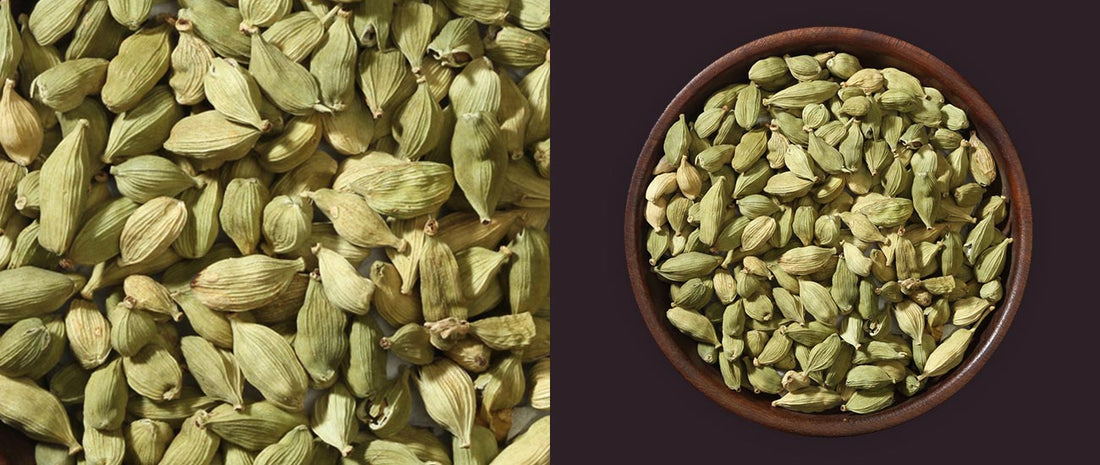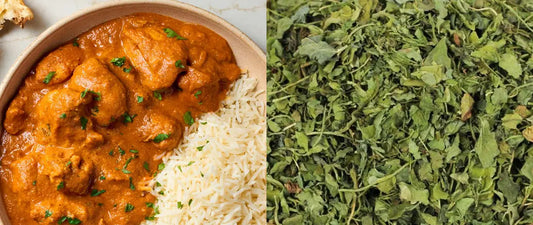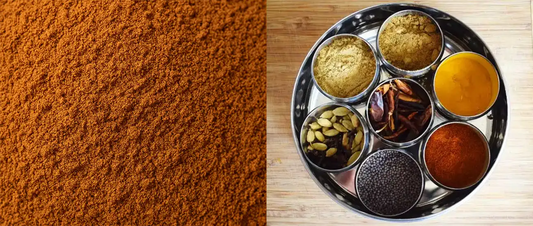
What is Cardamom? Complete Guide + Where to Buy
Quick Answer: Cardamom is an aromatic spice from the ginger family, known as the "Queen of Spices." It comes in green and black varieties, with green being most common for cooking and baking.
Table of Contents
Cardamom, those small, aromatic treasures, are an essential spice in the world of cuisine. With a rich history and a multitude of culinary applications, these little green and black pods are much more than just flavour enhancers. In this article, we'll delve into the fascinating world of cardamom, exploring its origins, flavours, culinary uses, and health benefits.
What Is Cardamom?
Cardamom originate from a variety of plants within the Elettaria and Amomum genera, both members of the ginger family (Zingiberaceae). These plants thrive in tropical areas, with notable cultivation regions such as India, Sri Lanka, and Guatemala.
Cardamom pods are spindle-shaped, with a triangular cross-section. They are about 1-2 inches long and 1/4 inch wide and have a thin, papery outer shell. These pods can vary in size and colour, ranging from pale green to black, depending on their maturity and processing methods. The pods contain small, aromatic seeds, which are the source of cardamom's unique flavour and aroma.

Did you know? Cardamom is known as the "Queen of Spices".
Types of Cardamom
Cardamom comes in two primary varieties, each with distinct characteristics shaped by their botanical differences and culinary usage.
- Green Cardamom (Elettaria cardamomum): Also known as "true" or "small cardamom," Elettaria cardamomum is the more prevalent and widely used variety. These green cardamom pods are known for their fresh, citrusy, and slightly sweet flavour, with subtle herbal notes. Due to their versatile nature, green cardamom pods find their way into a wide range of culinary applications, from sweet to savoury dishes. They are also a key ingredient in popular beverages like chai tea.
- Black Cardamom (Amomum subulatum): Also referred to as "brown cardamom" or "large cardamom." The differences in flavour between green and black cardamom arise from their distinct species. Black cardamom pods offer a unique smoky, earthy flavour with hints of camphor. They are primarily employed in savoury dishes, particularly in the cuisines of India and Tibet, to impart a deep and robust aroma.
Green cardamom is more popular and widely used in culinary traditions worldwide, making it easier to find in most supermarkets and grocery stores. However, it tends to be more expensive due to its widespread demand and the labour-intensive harvesting process required to obtain the small seeds from the pods.
| Feature | Green Cardamom | Black Cardamom |
|---|---|---|
| Flavor | Fresh, citrusy, sweet | Smoky, earthy, camphor |
| Size | Small (1-2 inches) | Large (2-3 inches) |
| Uses | Sweet & savoury dishes | Mainly savoury dishes |
| Price | More expensive | Less expensive |
| Availability | Widely available | Specialty stores |

Culinary Uses
Cardamom is incredibly versatile in the kitchen. They are a staple in many cuisines and are used in both traditional and modern dishes. Here are some common culinary applications:
- Baking: Ground cardamom or freshly crushed seeds add a delightful flavour to cookies, cakes, and bread. For example: Cardamom Coffee Cake, Cardamom Rolls, Cardamom Chocolate Chip Cookies.
- Curries: Cardamom is often included in spice blends for curries, lending a warm, sweet aroma to these dishes. For example: Chicken Tikka Masala, Biryani, Lamb Rogan Josh.
- Rice and Grain Dishes: A few crushed cardamom can elevate the flavour of rice and grain-based dishes. For example: Biryani, Pilaf (Pulao), Kheer (Rice Pudding).
- Desserts: Cardamom pairs wonderfully with sweets, infusing flavours into dishes like rice pudding and ice cream. For example: Chai Tea, Keer (Rice Pudding), Cardamom Saffron Ice Cream, Chai Spiced Cookies, Gulab Jamun.

Health Benefits
Cardamom pods not only enhance the flavour of your dishes but also offer potential health benefits:
- Antibacterial properties: Cardamom contains compounds that have been shown to be effective against a variety of bacteria, including Salmonella, Escherichia coli, and Staphylococcus aureus. This suggests that cardamom may help to prevent food poisoning and other infections.
- Improved blood sugar control: Cardamom may help to improve blood sugar control in people with diabetes. A study of people with type 2 diabetes found that taking cardamom supplements for 12 weeks resulted in a significant decrease in blood sugar levels.
- Reduced inflammation: Cardamom contains antioxidants and other compounds that have anti-inflammatory effects. This suggests that cardamom may help to reduce inflammation throughout the body, which may protect against chronic diseases such as heart disease, cancer, and arthritis.
- Improved heart health: Cardamom may help to improve heart health in several ways. It may help lower cholesterol levels, reduce blood pressure, and improve blood circulation.
- Fresh breath: Cardamom has been used for centuries as a breath freshener. Chewing on cardamom seeds or pods can help to kill bacteria that cause bad breath.
Please note that we're not health professionals, and the information provided is solely based on research - click the links above to view the sources. We recommend consulting with a medical professional before making any changes to your diet or lifestyle.
Difference Between High & Low-Quality Cardamom
If you're in the market for some cardamom, it's a good idea to know the difference between high quality and lower quality. Here are 3 pointers to help you make the right choice:
- Appearance: Look for cardamom pods that have a plump and vibrant green hue for green cardamom or a deep brown shade for black cardamom. The pods should feel firm and free from any signs of moisture or mould. Avoid pods that appear shrivelled, discoloured, or damaged.
- Aroma: The sign of good quality cardamom is its strong aroma. High-quality pods release a robust, fragrant scent when gently crushed or opened. This aroma should be inviting and indicative of freshness. Avoid pods with a faint or unpleasant odour, as it may signify staleness or inferior quality.
- Size and Shape: Generally, larger cardamom pods tend to contain more flavourful seeds. Look for pods that are well-formed and not excessively small or misshapen.
Storage & Shelf Life
To store cardamom pods effectively, transfer them into an airtight container immediately after purchase, preferably one that is opaque to shield them from light. Place this container in a cool, dark location, away from temperature fluctuations and moisture, as both can compromise the quality. Keeping the pods whole (rather than grinding or crushing) until use is advisable to retain their essential oils and flavour. When stored under these conditions, cardamom pods can maintain their freshness for up to a year, though for the best flavour, consider replacing them annually or when their aroma and taste noticeably diminish.
Read our article: 7 Simple Tips to Maximise Freshness of Spices

How to Use Cardamom Pods in Cooking
To make the most of cardamom, here's a simple guide:
- Crack the Pods: Begin by gently cracking the cardamom pods. You can achieve this by using a mortar and pestle or the flat side of a knife. This step releases the aromatic seeds.
- Extract the Seeds: Once the pods are cracked, carefully open them up to reveal the tiny, flavourful black seeds hidden within. These seeds are the essence of cardamom that you'll incorporate into your cooking.
- Use Sparingly: Keep in mind that cardamom is a potent spice, and a little can go a long way. Start with a small quantity of the extracted seeds in your recipe and adjust to your preferred level of flavour intensity. This approach ensures that the distinctive cardamom essence complements your dish without overpowering it.
When to Use Cardamom Pods vs. Ground Cardamom
The choice between cardamom pods and ground cardamom largely depends on the specific culinary application and the flavour profile you aim to achieve. Here's a breakdown of when to opt for each form:
Cardamom Pods:
- Infused Dishes: Whole cardamom pods are ideal for dishes where you want a gentle and nuanced infusion of cardamom flavour. This includes long-simmered dishes like soups, stews, and rice preparations. The pods release their flavour slowly without overwhelming it.
- Aromatic Teas and Infusions: Cardamom pods are commonly used to flavour teas and herbal infusions. They add a fragrant note and a mild cardamom taste.
- Visual Appeal: Whole cardamom pods can also be used for presentation purposes in certain dishes. They add visual interest and can be easily removed before serving.
Ground Cardamom:
- Baking and Desserts: Ground cardamom is a go-to choice for baking and dessert recipes. Its fine texture disperses evenly in batters, doughs, and mixes, allowing for a consistent and pronounced cardamom flavour in cakes, cookies, pastries, and other sweet treats.
- Quick Dishes: When you need the cardamom flavour to infuse rapidly and uniformly into a dish, such as in sauces, marinades, or quick-cooking recipes, ground cardamom is your best bet. Its potency ensures that the flavour is distributed quickly throughout the dish.
- Spice Blends: Ground cardamom is often used in spice blends like garam masala and curry powder. Its convenient form allows it to blend seamlessly with other spices.

Cardamom Alternatives
Cardamom is a unique spice, but it's not always readily available or affordable. If you find yourself without cardamom, there are a number of good alternatives that you can use instead, such as cinnamon, nutmeg, allspice, ginger, and cloves.
When choosing a substitute, consider the flavour profile of the dish you are making and start with a small amount, adjusting to taste as needed. Experiment with different cardamom substitutes to find the ones that you like best and that work best in your favourite recipes.
Frequently Asked Questions
What is cardamom used for?
Cardamom is used in both sweet and savoury dishes, from Indian curries and biryanis to Scandinavian pastries and Middle Eastern coffee. It's also valued for its potential health benefits.
What does cardamom taste like?
Green cardamom has a fresh, citrusy, slightly sweet flavor with herbal notes. Black cardamom is more smoky and earthy with hints of camphor.
Is cardamom expensive?
Yes, cardamom is one of the world's most expensive spices after saffron and vanilla, due to labor-intensive harvesting.
Can I substitute cardamom?
While no substitute perfectly matches cardamom's unique flavour, cinnamon, nutmeg, or allspice can work in small amounts.
Conclusion
Cardamom is more than just a spice; they are a gateway to a world of flavours and aromas. Whether you're using them in savoury dishes, sweet treats, or beverages, cardamom pods add a touch of magic to your culinary creations.


